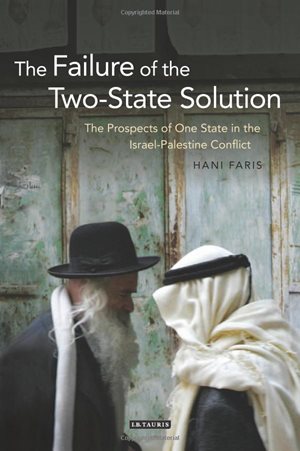
Publisher: I.B.Tauris & Co Ltd
Series: Library of Modern Middle East Studies Hardback ISBN: 9781780760940
Diplomats, politicians and activists alike have long laboured under the assumption that a two-state solution is the only path to peace between the Israelis and the Palestinians. But as this goal has not come to fruition, and the ever-elusive scepter of peace slips further from reach, violence and instability deepen. This book discusses another–until recently unthinkable-option: a single bi-national state in Israel-Palestine, with all inhabitants sharing in equal rights and citizenship, regardless of ethnicity or faith. It is the first rigorous exploration of this innovative and controversial alternative that has entered the discourse surrounding the peace process. With scholars from both sides of the conflict analysing the possibility of a one-state solution and the shortcomings of the two-state track, this is an important and ground-breaking book for students of Politics, International Relations, Peace Studies and Middle East Studies and all interested in the resolution of this intractable conflict. Contributors include Salman Abu Sitta, Omar Barghouti, Nadia Hijab, Gharda Karmi, Ilan Pappe, Gabriel Piterberg, Virginia Tilley and Husam Zomlot.
Chapter Eleven
The history of the Zionist-Palestinian conflict is full of landmarks. To name a few, the 1897 founding in Basle, Switzerland, of the World Zionist organization which set the stage for the ongoing conflict, the 1948 declaration of the establishment of Israel in Palestine, and the war of June 1967 which resulted in the Israeli occupation of the whole of Palestine. Common to the history of the conflict is the planned, and still continuous, ethnic cleansing operation against the indigenous population of the land.
There is a sense of permanence in all of this. During the long period of the conflict, Zionism had three objectives which are still very much in force, namely; occupying and acquiring Palestinian land, expelling its inhabitants, and erasing their history, memory and identity. To achieve these objectives, Zionists needed to manufacture and propagate a myriad of myths such as: Palestine is a land without people; there is no such thing as Palestinians, they do not exist; the Palestinians left their homes and country in 1948 on Arab governments’ orders; refugees may not return to their ancestral villages which no longer exist and their former sites have been built over and so on.
In spite of all, the Palestinians are still here, growing and resisting. They are a prime player in Middle East events. Strangely enough, a weird stalemate between the might of a colonial power and a defenseless people exists and the outcome is open to a myriad of possibilities since it is a changing and dynamic situation. Meanwhile, the machine of death and destruction will continue to wreak havoc on both sides, however disproportionately, until a settlement is reached. Will and should such a situation be allowed to continue? The answer is emphatically no. To achieve this end, a form of durable justice must be attained.
There are a number of geographic, demographic, political and military factors which hinder the application of an equitable solution to the conflict. It is the position of this author that all these factors are manageable except one; namely, the dominance of the ideology and practice of Zionism and its associated policies of racism and apartheid. Although this is central, this essay does not attend to this issue. Instead, it concentrates on the geographic and demographic factors to show whether they could serve the cause of justice or not. Although the problems associated with those factors are of a second tier nature, they indicate once more that Zionism is the primary obstacle to achieving peace and justice and bringing an end to this chronic conflict.
The thesis this essay presents has not been examined in depth by any other scholar so far. Though the factual data that form its basis have been published by the author before, they remain unchallenged by other scholars. The essay proposes to demonstrate that it is feasible to repatriate a large number, if not all, of the Palestinians in the ‘shatat’, i.e. exile, to their original places of residence and rebuild Palestine into one country. Any resulting dislocations will be manageable. To substantiate this thesis, three elements need to be considered and defined clearly; namely, the land of Palestine, the people of Palestine and the law of the land.
The Land
Palestine is a well documented country. The Byzantines had a detailed inventory of Palestinian villages in the 4th century. The Ottomans had detailed books of taxation and census since 1596. The British Mandate produced, in its short term of 30 years, voluminous data on Palestinian land and people that became the basis of United Nations records.
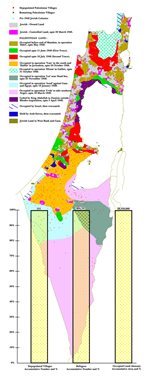 Fig-1: Al Nakba The Israeli conquest of Palestine in 1948/49 is shown at various stages of Israeli military operations. Source: Salman Abu Sitta, Atlas of Palestine 1917-1966. London: Palestine Land Society, 2010, p. 90.
Fig-1: Al Nakba The Israeli conquest of Palestine in 1948/49 is shown at various stages of Israeli military operations. Source: Salman Abu Sitta, Atlas of Palestine 1917-1966. London: Palestine Land Society, 2010, p. 90.
British records show that, at the end of the Mandate, Jewish ownership in Palestine reached 1,429 square kilometers out of Palestine’s area of 26,322 square kilometers. Thus, Jewish ownership was 5.4% of the area of Palestine, in spite of British collusion during the Mandate. But this small percentage was dwarfed during the war of 1948/1949 when, in a matter of a few months, Zionist forces captured 78% of Palestine. Palestinians refer to this development as ‘al-nakbah’ or catastrophe. The Palestinian lands conquered in 1948 are shown in [Fig-1]. It is important to recall that half of the refugees were expelled by Zionist forces before Israel was declared on 14 May 1948, before the British Mandate ended and before any Arab regular soldier set foot on Palestinian soil in order to assist its people.
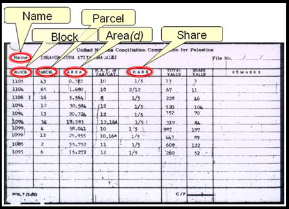 Fig-2: UNCCP Records A typical record of one of 453,000 Palestinian land owners. All Palestine is Palestinian Arab except those areas (5.4%) for which Jews possess legal title deeds. Source: United Nations Conciliation Commission on Palestine Registration Card.
Fig-2: UNCCP Records A typical record of one of 453,000 Palestinian land owners. All Palestine is Palestinian Arab except those areas (5.4%) for which Jews possess legal title deeds. Source: United Nations Conciliation Commission on Palestine Registration Card.
Eighty-five percent of Palestinian inhabitants of the land that is called Israel became refugees, and remained ever since. There is at the UN 453,000 records of individual Palestinian property owners defined by name, location and area, [Fig-2]. Given the detailed knowledge that exists of almost every parcel of land in Palestine, it is feasible to investigate what the Israelis did with the conquered Palestinian land.
In one of the curious twists of history, Ben Gurion anticipated there will be an international demand on Israel to restore conquered lands and property to its legal owners. To subvert such a possibility, Ben Gurion, then leader of the Provisional Government, and the Zionist command, fine tuned a plan to prevent the return of Palestinian refugees to their homes and property which was later demanded by UN Resolution-194 of the 11PthP of December 1948. He ordered the demolition of several hundred Palestinian towns and villages and entered into a fraudulent deal with the Jewish National Fund (JNF), an international Jewish organization registered as a tax-exempt charity in the USA and Europe. The deal was a fictitious sale contract of choice Palestinian land adjacent to the armistice line in order to prevent the return of the refugees. This way, he would claim that this land was not under his control. The data for this fictitious deal is shown in [Fig-3]. JNF had expropriated most of the property of 372 villages on which it established 116 parks under the slogan clean environment. JNF planted parks in order to hide the rubble of destroyed Palestinian homes and the cactus plants which refuse to disappear till this day.
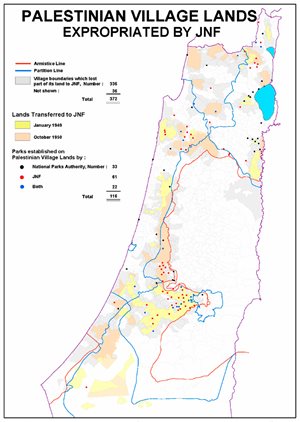 Fig-3: JNF Confiscated Land JNF confiscated 2,500,000 donums (1 donum=1/4 acres) which belonged to 372 Palestinian villages, comprising 55% of the registered refugees. Source of Parks’ identification: Noga Kadman, “Erased from Space and Consciousness-Depopulated Palestinian villages in the Israeli-Zionist Discourse” (Master’s thesis in Peace and Development Studies), Dept of Peace and Development research, Goteborg University, November 2001.
Fig-3: JNF Confiscated Land JNF confiscated 2,500,000 donums (1 donum=1/4 acres) which belonged to 372 Palestinian villages, comprising 55% of the registered refugees. Source of Parks’ identification: Noga Kadman, “Erased from Space and Consciousness-Depopulated Palestinian villages in the Israeli-Zionist Discourse” (Master’s thesis in Peace and Development Studies), Dept of Peace and Development research, Goteborg University, November 2001.
All the land acquired by the JNF during the Mandate and the Palestinian land seized by Israel is administered by the Israel Land Administration (ILA). The area under ILA varies according to various acts of expropriation but it ranges from 18,775 to 19,508 square kilometers. In order to examine the possibility of reconstructing Palestine after the destruction of its landscape and seizure of its land, consider the region bounded by Jaffa-Tel Aviv-Jerusalem corridor in the north, and Gaza in the south. This corridor was subject to great changes in the last sixty years due to rapid urban expansion and the concentration of the population in this area. The selected region envelops the southern portions of Tel Aviv, Central Israel and the inhabited upper Israeli Southern District according to the current administrative division in Israel. Other areas are less problematic.
[Fig-4] shows this region with its mostly Palestinian villages and their land area before 1948. All these villages, except 2, were ethnically cleansed by the Israelis in 1948. The population was expelled south towards the Gaza Strip and east towards the West Bank and Jordan. Their land was seized and used to expand urban development radiating from Tel Aviv to accommodate new immigrants.
[Fig-5] shows the same region with the present Israeli urban expansion. It is very clear that most sites of depopulated villages are still vacant, contrary to frequent Israeli claims. The same figure shows the land confiscated by JNF. The land is allocated to some Kibbutzim in the area. As shown in [Fig-15], the total rural population in the upper Southern District, which comprises the larger area of the selected region, is smaller than the population of one refugee camp in the Gaza Strip.
This vast area of land, sparsely populated, with only marginal agricultural output, is not of any particular vital socio-economic importance to the large settled Israeli population elsewhere. The real reason for holding to it is to prevent the return of the land owners to their homes and to have it as a strategic reserve for the future. This reserve is now used to house and maintain Israel’s war machine which is constantly expanding. The attempt to populate the Southern District with new immigrants has achieved limited success in spite of the strenuous efforts of the JNF. [Fig-6] shows the same region with some of the military and strategic locations and closed areas containing military bases, factories, training grounds, missile bases and WMD depots. The density of these sites is unparalleled by any other country. Their disappearance will no doubt serve the cause of peace.
The illustrations in figures 4, 5 and 6 sums up the original cause of the problem, the reason for the continuation of the conflict and the possible ways to end it. This analysis of land use is not a mere conjecture. Israeli records confirm the indicated land use in Israel in 1994 and as projected in 2020 [Fig-7]. It shows that most of the population lives on 12% of the Israeli land area, while 88% is used as a reserve land for the military, or protected, or closed areas, or vacant land. This includes 4,200 square kilometers of cultivated land, which uses a colossal 70%-80% of the overall water consumption, while producing only 1.5% of Israel’s GDP.
-
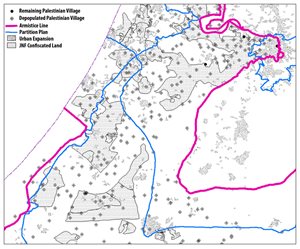 Fig-4: Southern Villages Ethnically cleansed villages and their land boundaries. Source: Salman Abu Sitta, Mechanics of Expulsion: The Perpetual Ethnic Cleansing. Lecture at SOAS London, 15 January 2011, available at: click here. Adapted from Fig-19 A-E.
Fig-4: Southern Villages Ethnically cleansed villages and their land boundaries. Source: Salman Abu Sitta, Mechanics of Expulsion: The Perpetual Ethnic Cleansing. Lecture at SOAS London, 15 January 2011, available at: click here. Adapted from Fig-19 A-E.
-
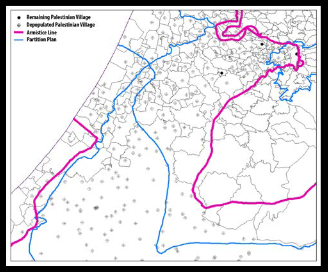 Fig-5: Urban Expansion and JNF Confiscation Same as Fig-4 showing that village sites are still vacant in spite of Israeli urban expansion. The figure shows JNF-confiscated Palestinian lands. Source: Salman Abu Sitta, Mechanics of Expulsion: The Perpetual Ethnic Cleansing. Lecture at SOAS London, 15 January 2011, available at: click here. Adapted from Fig-19 A-E.
Fig-5: Urban Expansion and JNF Confiscation Same as Fig-4 showing that village sites are still vacant in spite of Israeli urban expansion. The figure shows JNF-confiscated Palestinian lands. Source: Salman Abu Sitta, Mechanics of Expulsion: The Perpetual Ethnic Cleansing. Lecture at SOAS London, 15 January 2011, available at: click here. Adapted from Fig-19 A-E.
-
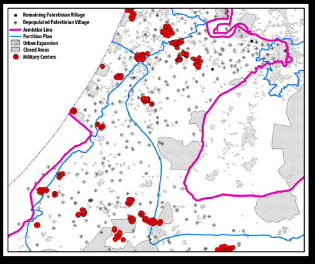 Fig-6: Military Use of the RegionSame as Fig-4 showing that Palestinian land is used primarily for military purposes. Source: Salman Abu Sitta, Mechanics of Expulsion: The Perpetual Ethnic Cleansing. Lecture at SOAS London, 15 January 2011, available at: click here. Adapted from Fig-19 A-E.
Fig-6: Military Use of the RegionSame as Fig-4 showing that Palestinian land is used primarily for military purposes. Source: Salman Abu Sitta, Mechanics of Expulsion: The Perpetual Ethnic Cleansing. Lecture at SOAS London, 15 January 2011, available at: click here. Adapted from Fig-19 A-E.
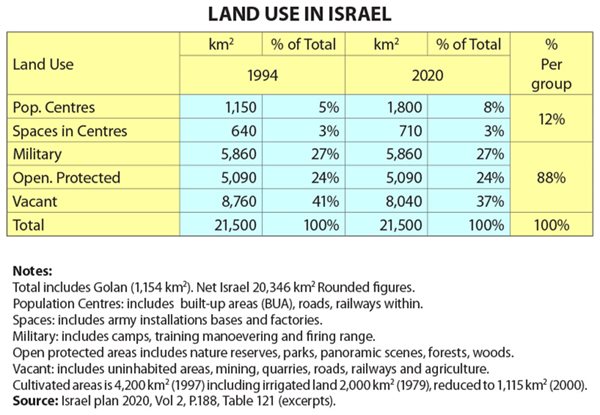 Fig-7: Land Use in Israel Official classification of land use showing that 88% of Israel is used for purposes other than human habitation.
Fig-7: Land Use in Israel Official classification of land use showing that 88% of Israel is used for purposes other than human habitation.
The People
The second element in the reconstruction of Palestine as one country is people. Today, there are about 11 million Palestinians who are living in the ‘shatat’ or in historic Palestine. Pitted against them are 5.5 million Jews who are mainly immigrants from or after the British Mandate period, including West Bank settlers, but now citizens of Israel. How did this come about?
-
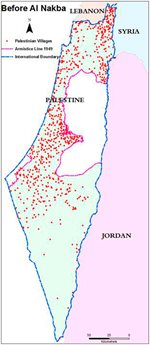 Fig-8: At home 1300 Palestinian villages in all of Palestine. Only 99 remained in the part of Palestine that became Israel. Others in that part were ethnically cleansed. Source: Salman Abu Sitta, Atlas of Palestine 1917-1966. London: Palestine Land Society, 2010, p. 122.
Fig-8: At home 1300 Palestinian villages in all of Palestine. Only 99 remained in the part of Palestine that became Israel. Others in that part were ethnically cleansed. Source: Salman Abu Sitta, Atlas of Palestine 1917-1966. London: Palestine Land Society, 2010, p. 122.
-
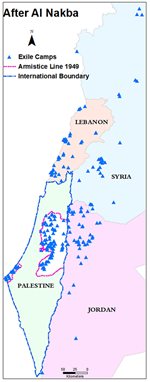 Fig-9: In Exile They were scattered in over 200 locations of refugee camps, not allowed to return home. Source: Salman Abu Sitta, Atlas of Palestine 1917-1966. London: Palestine Land Society, 2010, p. 122.
Fig-9: In Exile They were scattered in over 200 locations of refugee camps, not allowed to return home. Source: Salman Abu Sitta, Atlas of Palestine 1917-1966. London: Palestine Land Society, 2010, p. 122.
-
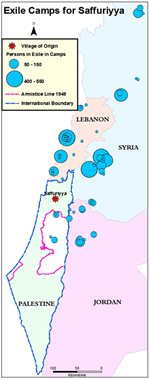 Fig-10: Saffouria Exile Those expelled from Saffouria village in Galilee sought refuge in adjacent regions, mostly Syria and Lebanon. Source: Salman Abu Sitta, Mapping Palestine: for its Survival or Destruction? Lecture at Palestine Canter, Jerusalem Fund, Washington DC, 28 April 2011, available at: click here. Adapted from Fig-19C.
Fig-10: Saffouria Exile Those expelled from Saffouria village in Galilee sought refuge in adjacent regions, mostly Syria and Lebanon. Source: Salman Abu Sitta, Mapping Palestine: for its Survival or Destruction? Lecture at Palestine Canter, Jerusalem Fund, Washington DC, 28 April 2011, available at: click here. Adapted from Fig-19C.
-
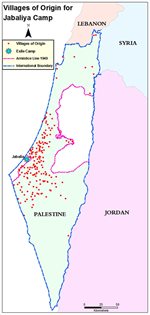 Fig-11: Villages of Origin for Jabaliya Camp Jabaliya camp pulverized by Israeli tanks and planes is the temporary home of tens of ethnically cleansed southern villages. Source: Salman Abu Sitta, Atlas of Palestine 1917-1966. London: Palestine Land Society, 2010, p. 149.
Fig-11: Villages of Origin for Jabaliya Camp Jabaliya camp pulverized by Israeli tanks and planes is the temporary home of tens of ethnically cleansed southern villages. Source: Salman Abu Sitta, Atlas of Palestine 1917-1966. London: Palestine Land Society, 2010, p. 149.
Before al-Nakbah, there were 1304 ‘villages’ in Palestine of which 956 came under Israeli rule [Fig-8]. Of these, 773 were Palestinian Arab villages. Israeli ethnic cleansing depopulated the majority, i.e. 674, with only 99 villages evading depopulation. The inhabitants of depopulated villages were exiled into 602 locations, registered and served by UNRWA [Fig-9]. Non-registered refugees live in various Arab and foreign countries. For registered refugees, UNRWA records show who they are, where they are from originally in Palestine and where they were exiled to. As an example, take the case of Saffouria, a village in Galilee [Fig-10]. Some inhabitants found refuge in nearby Nazareth. The majority were expelled to Lebanon, Syria, Jordan and the West Bank. Given that they and their descendants are known, it is possible to reconstruct their return from exile camps to their villages of origin. In other words, the process of ethnic cleansing that took place can be reversed with high reliability. Another case is that of Jabalyia Camp in Gaza which was pulverized by F16s and Israeli tanks in the December 2008 to January 2009 Israeli assault. The original villages of those people who took refuge in Jabalyia Camp, their ‘hamulas’ (extended families), even their individual names, are known, [Fig-11]. But Gaza has a special significance. Two hundred and forty seven villages in the Southern District of Mandate Palestine, i.e. Gaza and Beersheba sub-districts, were depopulated and their inhabitants expelled to the tiny Gaza Strip, [Fig-12]. They are huddled in 8 camps in a strip which is 1% of the area of Palestine, besieged from land, sea and air, and subjected to extreme deprivation. The adjacent Israeli town of Sderot, which is frequently in the news, is built on the land of Najd village whose people are now refugees in Gaza, two kilometers away. Today, 1.5 million people live in this most crowded place on earth. Not only were they expelled in 1948, but they have been attacked constantly in their exile ever since.
From a logistical point of view, the restoration of the Palestinian refugees to their land is possible as illustrated above. They are very close to their homes. Their numbers are manageable. In general, their return can be effected in 7 phases; each phase involving about half a million people. In Galilee, they can return to their villages without the need to efface exiting construction or uprooting the present inhabitants. An examination of the origin and distribution of the present occupants is in order. They can be classified into five categories:
- Palestinians who managed to remain at home.
- Ashkenazim who conquered the country in 1948.
- Jews from Arab countries who were brought in the 1950’s to fill the void after the expulsion of the Palestinians.
- Russians who immigrated en masse for about 5 years starting in 1989 after the demise of the Soviet Union.
- Assorted European and American Jews who came intermittently, particularly after the 1967 occupation of the West Bank, Gaza and the Golan.
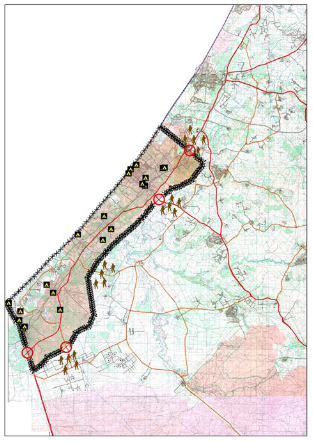
This broad classification shows approximately who is filling the places from which Palestinians were expelled. It is based on the author’s research of immigration to Israel over the years, and on the geographical distribution and placement of these immigrants. This research covered over a thousand now–Israeli towns and villages. Of these, the findings indicate that less than 50 have a sizeable population. The rest are small settlements: kibbutzim and Moshavim, each with an average population of 300-500 people. At the same time, the author studied the Palestinian population of 674 ethnically-cleansed towns and villages. Their home villages and their exile camps were traced using the records of the United Nations Relief and Works Agency (UNRWA). Based on the voluminous data collected, it was possible to chart a plan of return.
In the present Israeli Northern District, a sizeable percentage of the population is still Palestinian. [Fig-13] shows both the present population and the returning Palestinians. There does not seem to be a problem of over lapping or crowding. Refugees can take a bus and return to live in their homes with their kith and kin. It is a matter of conjecture to forecast how many Jews would wish to remain in a democratic, non-exclusive country. Similarly, it is not certain how many Palestinians would wish to return or remain where they are. In either case, Jews must have the choice and the Palestinians must be able to exercise their inalienable Right of Return.
The same exercise can be applied to the present Israeli Southern District, which is actually much less of a problem. [Fig-14] shows the existing population classified as in the Northern District. With the exception of 3 originally Palestinian towns, now inhabited and expanded by Israeli Jews, all the rural Jews in this area (73,000) hardly fill one refugee camp in Gaza. The existing population and the returning refugees are almost the same number, 800,000 each. If Gaza refugees return, they can literally walk to where their homes were within an hour. Housing for the returning Palestinians is also not a problem. The author researched this matter and found that the destroyed homes, less than one million housing units, can be rebuilt entirely by Palestinians. 18 Similar or larger projects were built in the Gulf where Palestinian engineers played a key role. It is evident, therefore, that from the physical and logistical points of view, the whole process of repatriation and rehabilitation is quite manageable.
-
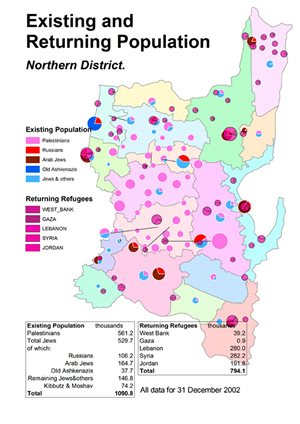 Fig-13: Northern District The return of the expelled population of Galilee will be welcomed by their families who remained at home. Source: Salman Abu Sitta, Atlas of Palestine 1917-1966.London: Palestine Land Society, 2010, p. 150.
Fig-13: Northern District The return of the expelled population of Galilee will be welcomed by their families who remained at home. Source: Salman Abu Sitta, Atlas of Palestine 1917-1966.London: Palestine Land Society, 2010, p. 150.
-
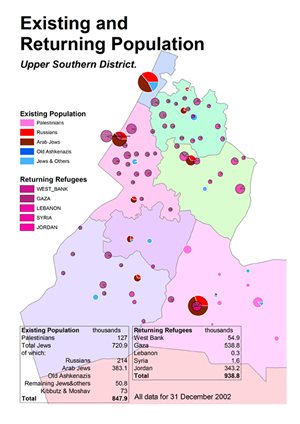 Fig-14: Southern District Total ethnic cleansing of the south left the south almost empty till today. Expelled Gaza refugees can literally walk home. Source: Salman Abu Sitta, Atlas of Palestine 1917-1966.London: Palestine Land Society, 2010, p. 150.
Fig-14: Southern District Total ethnic cleansing of the south left the south almost empty till today. Expelled Gaza refugees can literally walk home. Source: Salman Abu Sitta, Atlas of Palestine 1917-1966.London: Palestine Land Society, 2010, p. 150.
As far as the Jewish population of Israel, their origin, date of immigration and numbers are well documented by Israel’s Central Bureau of Statistics (CBS). According to Ian Lustic who analyzed CBS data from 1998-2000, CBS figures show an average of approximately 13,000 annual Israel emigrants leaving the country. The average for the 4 years after the outbreak of the 2000 Al-Aqsa Intifada showed an increase of nearly 40% to 18,400 emigrants per year. According to Lustic, “A similar 40% increase in the number of Israeli immigrants gaining permanent residency or citizenship in the US, Canada, and UK was registered between the 5 years prior to the outbreak of the Al-Aqsa Intifada and the 5 subsequent years. That is a jump from 25,276 in the years 1996-2000 to 35,372 in the years 2001-2005”. A report attributed to the CIA estimates that in the next 15 years, two million Israelis, including half a million who currently hold US green cards or passports will move to the United States, and 1.6 million Israelis would return to Russia and Eastern Europe. It is of interest to note that at any calendar year, about three quarters of the Israelis travel outside the county. These of course are estimates which could be wildly out of line, but the important point is that most Israeli Jews have or had a passport, citizenship and likely a home outside Israel, while the majority of Palestinians do not have that option and do not wish to have it. Also, the Jewish population in Israel is fluctuating, variable and not always predictable. On the other hand, the Palestinian population is defined, stable and steadily growing.
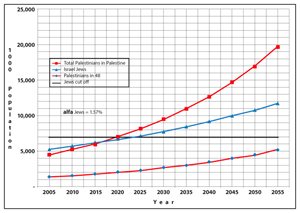 Fig-15: Population Projection All projections show that Palestinians will be the majority at some place or time. Hence renewed ethnic cleansing plan is discussed publicly in Israel. Source: Salman Abu Sitta, Atlas of Palestine 1917-1966. London: Palestine Land Society, 2010, p. 152.
Fig-15: Population Projection All projections show that Palestinians will be the majority at some place or time. Hence renewed ethnic cleansing plan is discussed publicly in Israel. Source: Salman Abu Sitta, Atlas of Palestine 1917-1966. London: Palestine Land Society, 2010, p. 152.
There is a prevalent racist attitude in Israel that calls the presence and growth of Palestinians in the country “a demographic bomb”. Such is the nature of Zionist ideology which is on a collision course with human rights. Short of a holocaust to annihilate the Palestinians, it is a futile objective. [Fig-15] shows the Palestinian and Jewish population projection in Palestine. It shows the Jewish and Palestinian citizens of Israel as having a natural growth of 1.57% until the year 2055. The top line shows total Palestinians living in the three regions, i.e. Israel, West Bank and Gaza, which form historic Palestine. The Palestinians in exile (not shown) who reside outside the borders of Palestine are approximately the same number. Anywhere between 2015 and 2017, Palestinians in all of Palestine will be equal to Israeli Jews. If a strict definition of a “Jew” is applied, the Palestinians are probably already equal in numbers to Israeli Jews. In the year 2050, Palestinians will be around 17 million and Israeli Jews will be 11 million if the present trend continues without interruption. But this is not the point.
The number of Jews in the world is almost constant at 13 million because of mixed marriages and assimilation. Israeli policy seems to have resigned itself to American and Western European Jewry not wanting to immigrate to Israel and may even be amenable to them remaining in their countries of residence since their presence there is considered strategically beneficial to Israel. This explains why Israeli planners concentrate on attracting Jews of Eastern Europe, Russia, Africa and Asia to move to Israel. That means there is a limited reservoir among World Jewry of potential residents or immigrants to Israel, shown in the thick horizontal black line. Accordingly, the Palestinians will undoubtedly be the majority in the future and/or in certain regions of Palestine. The uncertainly is only where and when. That is the reason for the new Israeli demand that Israel be recognized by Palestinians as a “Jewish state”. This is contrary to the Israeli declaration of independence itself which relies for its legitimacy on the 1947 U.N. Partition Plan which never envisaged a purely ethnic or religious state, nor could it ever do so. The slogan “Jewish state” is therefore meant to deny the right of refugees to return to their homes and to provide a license for Israel to expel its own Palestinian citizens as and when it deems it appropriate.
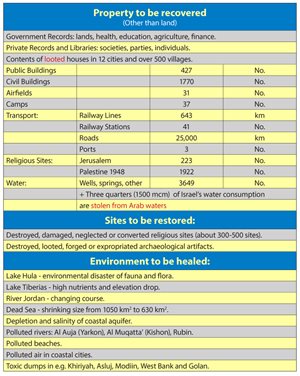
The Law
The third element in reconstructing Palestine, next to land and people, is the law that needs to prevail in the country and the mechanism by which it is applied. For Palestine, international bodies and organizations, particularly the United Nations, have been involved in the issue for some ninety years. Their legal foundations and their policies and decisions can guide future actions. In them, the bases for establishing a democratic free government can be found in Article-22 of the Covenant of the League of Nations, the Universal Declaration of Human Rights and the Right to Self Determination. Though far from being optimal, UN Resolution-181 partitioning Palestine has some useful and necessary provisions to protect the political, civil, religious and educational rights of each group, whether Palestinian or Jewish. This should be a good basis from which an expanded formula can be developed for one country. Upholding UN Resolution-194 which has been affirmed by the international community over 135 times in the last 60 years, more than any other resolution in UN history, is also imperative. It has 3 main elements: First, it calls for the refugees to return; second, it provides them with relief until that happens; third, and most importantly, it provides a mechanism for their repatriation and rehabilitation. This mechanism is the UN Conciliation Commission for Palestine (UNCCP).
In the Lausanne negotiations, 1949-1950, Israel managed to obstruct the refugees’ return and rendered UNCCP idle. The only provision of relief that survived, represented UNRWA, is still in operation. But UNCCP is still legally valid and has its offices within the UN. Its annual routine report is an indication of Israel’s contempt for international law and UN resolutions. The report says every year: “we are unable to facilitate the return of the refugees this year”.
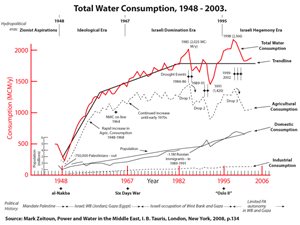 Fig-17: Total Water Consumption, 1948-2003 The increased consumption is due to Israel’s illegal diversion of Arab water, causing wars. Most of the consumption is used for agriculture with little economic return. Its purpose is to keep refugees’ land under Israel’s control to prevent their return. Source: Mark Zeitoun, Power and Water in the Middle East, I. B. Tauris, London, New York, 2008, p.134.
Fig-17: Total Water Consumption, 1948-2003 The increased consumption is due to Israel’s illegal diversion of Arab water, causing wars. Most of the consumption is used for agriculture with little economic return. Its purpose is to keep refugees’ land under Israel’s control to prevent their return. Source: Mark Zeitoun, Power and Water in the Middle East, I. B. Tauris, London, New York, 2008, p.134.
In her writings, the noted legal scholar, Susan Akram, has outlined with much clarity the legal implications of applying the Right of Return. It should be clear then that a legal framework for a reconstituted Palestine is available and needs to be applied, as it was in dozens of similar cases such as Kosovo, Bosnia, Abkhazia, Uruguay, Uganda, South Africa, Iraq and Afghanistan. Needless to say, the real question that remains of course is whether or not the colonial powers that created the problem in the first place have the political will to enforce outstanding international resolutions and apply international legal standards of justice and equity. This can never take place unless they cease their opposition to the Palestinians’ human, political and national rights. This may be a pipe dream at the moment. Hopefully, world public opinion, which is slowly but steadily becoming less enamored by Israel’s fictional image and more empathetic to the cause of the Palestinians. Possible changes in the balance of power in the world would also improve the chances of the enforcement of human rights in Palestine. Whether this happens or not is the keystone in this equation. But the outcome depends on how much the Palestinian people remain determined to restore their rights. The past six decades indicate they have a huge reservoir of tenacity.
The increased consumption is due to Israel’s illegal diversion of Arab water, causing wars. Most of the consumption is used for agriculture with little economic return. Its purpose is to keep refugees’ land under Israel’s control to prevent their return. Source: Mark Zeitoun, Power and Water in the Middle East, I. B. Tauris, London, New York, 2008, p.134. When rights are restored and apartheid abolished, there is of course a lot of preparatory work to do. Sixty years of wars, occupation, war crimes, destruction and suffering cannot be wiped out easily. However, the history of Palestine has always been noted for its spirit of tolerance and absorption of diverse communities. The first task is to clean up Palestine. We have to restore Palestine, which is now concreted, polluted and ravaged, to normal life, [Fig-16]. Private and public property of Palestinians should be recovered. In particular, the important resource of water which is now wasted on cash crops and produces only 1.5% of Israel’s GDP must be restored to proper use.
[Fig-17] shows that two thirds of Israel’s water consumption was diverted from Arab sources. Water problems in the region emanate from misallocation and misuse, not necessarily from scarcity. Religious, archaeological and cultural Arab and Islamic sites should be restored or repaired. Wherever possible, the landscape has to be restored to its former pristine condition. Also, land, air and water, which have been greatly polluted by the mad rush to build, must be cleaned up. Palestine can provide a clean environment and a livable country for millions of people.